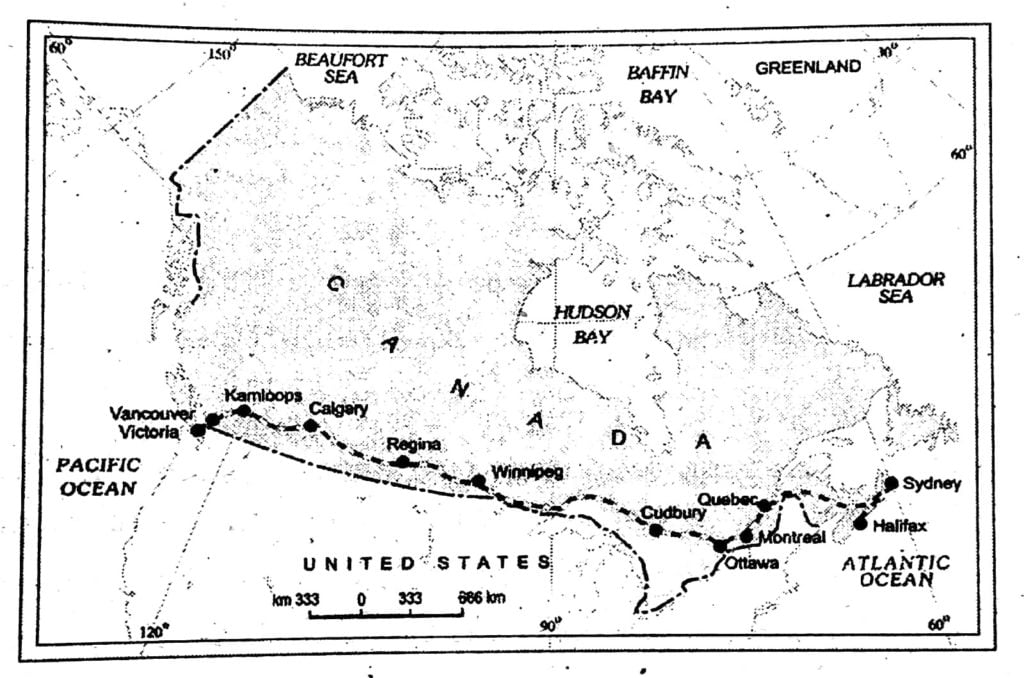Class 12 Geography Chapter 8 Transport and Communication Question answer to each chapter is provided in the list so that you can easily browse throughout different chapters SCERT Class 12 Geography Chapter 8 Transport and Communication and select need one.
Class 12 Geography Chapter 8 Transport and Communication
Also, you can read the SCERT book online in these sections Solutions by Expert Teachers as per SCERT (CBSE) Book guidelines. These solutions are part of SCERT All Subject Solutions. Here we have given Assam Board/NCERT Class 12 Geography Chapter 8 Transport and Communication Solutions for All Subject, You can practice these here…
Transport and Communication
Chapter: 8
PART-1
GEOGRAPHY
TEXTUAL QUESTION & ANSWER
Q.1. The Trans-Siberian Railway runs between
(a) Halifax and Vancouver
(b) Petersburg and Vladivostok
(c) Perth and Sydney
(d) Darwin and Melbourne
Ans :- (d) Darwin and Melbourne
Q.2. The Trans-Canadian Railway runs between
(a) Halifax and Vancouver
(b) Petersburg and Vladivostok
(c) Perth and Sydney
(d) Darwin and Melbourne
Ans :- (a) Halifax and Vancouver
Q.3. The Trans-continental Start Highway runs between
(a) Halifax and Vancouver
(b) Vancouver and St. John’s City
(c) Perth and Sydney
(d) Darwin and Melbourne
Ans :- (d) Darwin and Melbourne
Q.4. The Orient Express line runs from
(a) Strasbourg to Munich
(b) Vienna to Budapest
(c) Paris to Istanbul
(d) Munich to Belgrade
Ans :- (c) Paris to Istanbul
Q.5. Which country has the highest density of railway networks?
(a) USA
(b) Canada
(c) Brazil
(d) Russia
Ans: (a) USA
Q.6. The big Trunk Route runs through
(a) The North Pacific Ocean
(b) The Mediterranean Sea
(C) The North Atlantic Ocean
(d) The South Atlantic Ocean
Ans :- (c) The North Atlantic Ocean
Q.7. The Big Inch pipeline use to transport
(a) Water
(b) Mirk
(c) Petroleum
(d) Liquid Petroleum Gas (LPG)
Ans :- (c) Petroleum
Q.8. Road density means the length of road
(a) Per 1 square kilometer
(b) Per 10 square kilometer
(c) Per 100 square kilometer
(d) Per 1000 square kilometer
Ans :- (c) Per 100 square kilometer
Q.9. Rail density means the length of railways
(a) Per 1 square kilometer
(b) Per 10 square kilometer
(c) Per 100 square kilometer
(d) Per 1000 square kilometer
Ans :- (c) Per 100 square kilometer
Q.10. Which one of the following country records highest Highway tenth per 100 square kilometers
(a) USA
(b) India
(c) France
(d) Japan
Ans :- (a) USA
Q.11. What is a Transport Network?
Ans :- Several Places joined together by a series of routes to link each other and form a pattern. This pattern is called transport network.
Q.12. What are the major traffic solutions in big cities’?
Ans :- Higher parking fee, Mass Rapid Transit, Improved Public Bus service, Expressways are the major traffic solution in big cities.
Q.13. What are the major modes of transport?
Ans :- The major modes of transport are land, water, air and pipelines.
Q.14. What does an ocean freighter handle?
Ans :- International movement of goods is handled by ocean freighters.
Q.15. What do airways best move?
Ans :- Airways is the fastest means of transport than any other means of transport.
Q.16. What are Trans-continental railways?
Ans : Trans-continental railways are those railways which connect one part or end of the continent to the other end of the same continent. Examples: Trans-Siberian Railway, Trans Canadian Railways.
Q.17. What are the two types of water transport?
Ans :- The two major types of water transport are inland waterways and ocean routes including canal.
Q.18. On what do high living standards and quality of life depend?
Ans :- High living standards and quality of life depends upon efficient means of transport and communication.
Q.19. What do transport, communication and trade do?
Ans :- Transport, communication and trade turned the whole world into a Global Village.
Q.20. What do you mean by Pack Animals?
Ans :- Pack animals are those animals who carry passengers and freight from one place to another.
Q.21. What is Remote Sensing?
Ans :- Remote Sensing is the science and art of gathering, storing and extracting of geographic information from far distances.
SHORT TYPE QUESTION & ANSWER : (MARKS-3)
Q.22. What are Border Roads? Discuss major features of Border Roads?
Ans :- Strategically important roads in the bordering areas of the country are called border roads. Border Roads Organisation (BRO) which is a Government of India undertaking constructs and maintains border roads. This organisation was established in 1960 for the development of the roads of strategic importance in the northern and northeastern border areas. Border roads are important because they have improved accessibility in areas of difficult terrain. They have helped in the economic development of border areas
Q.23. How is water transport cheaper than other modes of transport?
Ans :- Water transport is the cheapest of all the means of transportation The route for water ways are naturally made. The maintenance cost of the route is cheaper than any other modes of transportation. The distance of water routes from one part to another is shortest. Besides, almost all countries are connected with sea routes. Where other means of transport are not available water transport plays a significant role. The probability of accidents is also less. Water vehicles can carry a large amount of goods in one time. So the water transport is cheaper than other modes of transport.
Q.24. Discuss the pipelines have been used for different purposes.
Ans :- Pipeline is one kind of important mode of transportation Pipeline is used extensively to transport liquids such as water crude oil, natural gas, etc. for an uninterrupted flow, where total and daily volume of demand is high and continuity of delivery is to be maintained. Pipeline transportation is dependable and safe. Plans are being made even to transport suspended solid through pipelines. Where supplies through pipelines are familiar to all Cooking gas or LPG is supplied through pipelines in many parts of the world. Pipeline also used to transport liquid coal. The disposal of sewage in the cities is done through pipelines. In New Zealand, milk is being supplied through pipelines from firms to factories. Crude oil is brought to the refinery sites generally located near the market on the refinery sites generally located near the market or seaport from the oil producing areas by pipelines. All the oil producing countries of the world have intensive pipelines for crude oil transportation.
Q.25. Discuss the major transport hindrances in the development of air transport.
Ans :- The manufacturing of aircrafts and their operations require elaborate infrastructure like hangars, landing fuelling and maintenance facilities for the aircrafts.
(i) The construction of airports is also very expensive.
(ii) It has developed more in highly industrialized countries where there is a large volume of traffic.
Q.26. Discuss the major features of the Trans Siberian Railways.
Ans :- The Trans-Siberian Railway is the major rail route that Russia runs from. St. Petersburg in the West to Vladivostok on the Pacific Coast in the east passing through Moscow-Ufa – Novosibirsk – Irkutsk – Chita and Khabarovsk. It is the most important route in Asia and the longest (9332 km) double – track and electrified trans-continental railway in the world

Q.27. Discuss the major features of the Trans Canadian Railways.
Ans :- The Trans-Canadian Railways runs from Halifax in the east to Vancouver on the Pacific Coast in the West. The railway line passes through Montreal-Ottawa-Winnipeg and Calgary. It was constructed in 1886. Initially, it was a part of an agreement to make British Columbia on the West Coast join the Federation of states. Later on, it gained economic significance because it connected the Quebec-Montreal Industrial Region with the wheat belt of the Prairie Region and the Coniferous Forest region in the north. The total length of the Trans-Canadian Railways is 7,050 km.

Q.28. Give an account of the Ocean waterways as a mode of transport.
Ans : The oceans offer a smooth highway traversable in all directions with no maintenance costs. It is the cheapest means of transport, especially. for foreign trade. They generally linked the importing and exporting countries. Compared to land and air, ocean transport is a cheaper means of haulage of bulky material over long distances from one to another continent.
Modern passenger liners and cargo ships are equipped with radar, wireless and other navigation aids. The development of refrigerated chambers for perishable goods, tanks has made cargo handling at the world’s major ports easier.
There are some major ocean routes in the world.
They are :
(a) The northern Atlantic sea Route.
(b) The suez canal routes.
(c) The Panama canal.
(d) The Mediterranean Indian ocean sea route.
(e) The cape of Good Hope sea Route.
(f) The pacific ocean route.
The northern Atlantic sea Route links North eastern USA and North western Europe. The two industrially developed regions of the world. The foreign trade over this route is greater than that of the rest of the world.
The Mediterranean Indian ocean Sea Route Passes through the heart of the old world and more countries and people than any other route. The cape of good Hope sea route across the Atlantic Ocean which connects west European and West African countries with South America. The suez canal and panama canal are two man-made navigation canals or waterways which serve as gateways of commerce for both the eastern and western worlds.
Q.29. Describe the major features of coastal shipping.
Ans :- The major features of coastal shipping are :
(i) Coastal shipping is a convenient mode of transportation than other modes of transportations.
(ii) Coastal shipping transported with long coastlines, eg. USA, China and India.
(iii) Coastal shipping connects one member’s coast with the other.
(iv) Coastal Shipping is a cheaper mode of transportation compared to others.
(v) It is properly developed, coastal shipping can reduce the congestion on the land routes.
See Next Page No Below…

Hi, I’m Dev Kirtonia, Founder & CEO of Dev Library. A website that provides all SCERT, NCERT 3 to 12, and BA, B.com, B.Sc, and Computer Science with Post Graduate Notes & Suggestions, Novel, eBooks, Biography, Quotes, Study Materials, and more.



